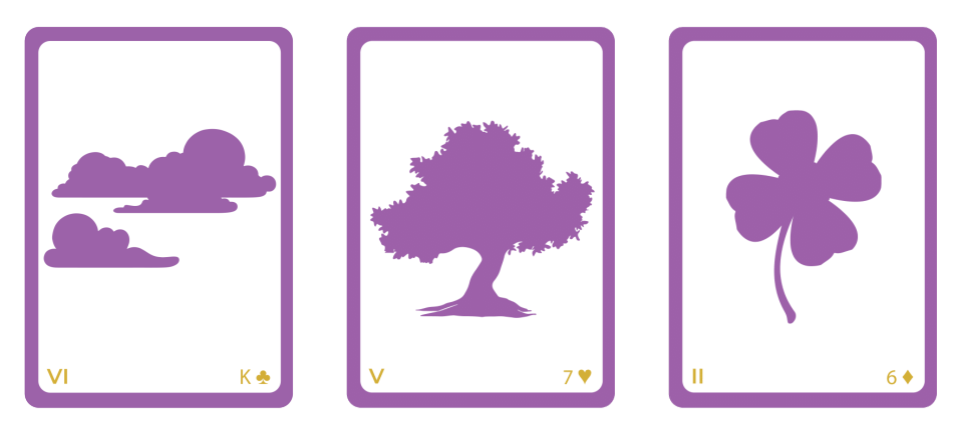
HOW TO KEEP IT SIMPLE WITH LENORMAND
We, humans, just have a knack for over-complicating things, don’t we?
This includes Lenormand, even when it’s cards are drawn from everyday symbols.
There are thousands of Lenormand spreads, hundreds of decks, several ‘systems’ to read the cards, and many books and websites that offer their take on the many card combinations.
But is this actually all useful? Do we really need all this knowledge? I don’t think so. I think we need more ‘how’ than ‘what’.
In my 20+ years of reading Lenormand, I must have gone through just about every nook and cranny on paper and online that tells us something about the cards, and I remain convinced that the best way to flow with Lenormand is by simply taking them at face value.
I’ve even come across Lenormand readers who’ve associated the strangest esoteric myths with the cards. Some folks out there want to make it complicated as though it helps them pass for know-it-all's on the subject. (Cue dimming lights and spooky music).
But the facts of the matter are (1) Lenormand’s history remains an unsolved mystery, and (2) the cards are brilliant precisely because of their simplicity.
Reading Lenormand doesn’t have to be hard. It doesn’t have to be complex. Even the longest sentences can be read smoothly like words in a sentences without memorizing anything. Unlike some people’s take on the Tarot, Lenormand’s deck doesn’t keep secrets or privileged information, and there aren’t secret societies around that propose to initiate you into Lenormand’s mysteries.
And it simply doesn’t make any sense to memorize card combinations. There are 630 card pairs, 7,140 card triplets, and 58,905 quadruplets… Let’s skip the silliness of listing quintuplets and beyond!
You’ll get the most out of your Lenormand deck when you keep it honest and simple.
And even if you’re a seasoned Lenormand Reader, I’ll bet that you sometimes feel you wouldn’t like the messages to be so straightforward and simple. I know - I’ve been there many times.
So how do we keep it simple with Lenormand? Here are my suggestion to the Lenormand Reader in you...
USE KEYWORDS
Keywords are an awesome tool for learning just about any subject. They help us summarize meaning into a condensed and accessible format, and give us clues about what additional meanings can be associated with a card.
I like to think of keywords as the tip of the iceberg. They’re those words we know off the top of our head, but they also help us dig deeper and go beneath the surface for more or expanded meanings of the card when we need to.
Most of us Lenormand Readers will have a Lenormand card keyword chart somewhere, whether we’ve kept it from our favorite Lenormand book, or compiled it ourselves. (Obviously, creating your own list of keywords is much more effective than just using someone else’s, but if you're starting out, download this free handy list).
Here’s a simple three-card reading for my question: What do I need to focus on for my business? I get the Clouds, Tree, and Clover.

Here’s my interpretation:
“The Clouds suggests that I need to sort out anything that’s confusing me. Focus is key. The Tree suggests this can take a bit of time and that a learning phase is in view. It encourages me to take things step by step but to keep at it consistently. The Clover is especially promising and indicates that I’m on the right track and should see positive results in time.
Yeay!
STICK TO 1-3 CARD SPREADS
The cornerstone of interpreting Lenormand’s cards is by reading them in combinations. The main combinations are two- and three-card sentences. Anything longer than usually just involves stringing the combinations together.
One-card readings help you learn the individual card meanings. Two-card readings help you learn simple combinations. And three-card readings help you string two card pairs together into a story. Even the largest Lenormand spreads, like the Grand Tableau, are interpreted using the same techniques.
When sentences get longer, it doesn’t necessarily mean they get more complex to interpret. They can of course, but more commonly, reading them is just about stringing their pairs or triplets into a story.
CHOOSE A CLEAR DECK OF CARDS AND STICK WITH IT FOR A WHILE
While the Lenormand deck is not as common as the Tarot, you’ll still find many decks to choose from.
My best advice to you is to choose a deck whose imagery is clear and stands out brightly. I’ve seen many decks who’s illustrations are a little, well, over-illustrated, and the main symbol doesn’t stand out too well against the background.
I also suggest that the playing card insets be clearly separate from the main image symbol. It’s also best when they’re not as large as the symbol.
Card size certainly matters to me, and it bewilders me why so many decks are tiny. I have big hands and need to be able to shuffle, fan, and pull cards easily. Keep card size in mind as it tends to be overlooked.
Finally, choose something that resonates with you and pleases you aesthetically.
Once you’ve selected the right deck, stick with it for some time. It will help you anchor your reading habit and build your vocabulary. Different card decks can inspire a different interpretation. While that’s okay, it’s not practical at the outset.
AVOID AUGMENTING OR REPEATING READINGS
You might know that readers will sometimes add a card or two to clarify cards of a completed reading. This is called augmenting. In my previous example, I might add a card on top of the Clouds to clarify what the confusion is about. While this can be a practical technique in some cases, I don’t encourage it as a habit or when you’re starting out.
The reason is that you’ll start distrusting the existing cards and avoid deepening your understanding of their meaning - and then you’ll never be satisfied with your readings.
Similarly, you shouldn’t do readings over and over about the same question. You should do a reading only once, and give the matter time to evolve in real life before asking about it again.
Adding cards or drawing them over and over for the same question will compromise your growth as a Lenormand Reader. You need to trust yourself to interpret the cards well for a given query, and that’s what practicing will help you achieve.
NO NEED FOR ESOTERIC SYSTEMS
Unlike the Tarot and other practices that are often associated with mystical systems, Lenormand’s deck is very practical and down to earth. That’s likely because of its everyday symbolism and how easily we connect with it.
Some authors have tried to expand on the mystical meaning of the symbols or the pips. I explore this topic through what I call card correspondences, but it’s not for the purpose of magical practice. It’s rather to keep expanding my vocabulary so I easily interpret the cards in any context.
The need for a mystical system often diverts our attention from the plain and simple message that the cards are delivering. This might sound odd, but it’s actually a down to earth and a non-magical approach that will help us become good readers.
Want To Become A Lenormand Reader?
Lenormand Reader’s Certification Program is the only one of its kind, in size and in depth, to help you master the amazing Lenormand deck. This Program is filled with knowledge and practice accumulated through 20+ years of study and practice. It is organized into a real body of knowledge and delivered with best in class, online, on-demand video. Join the waitlist so you secure your spot when registration opens.
Join Lenormand Reader’s Certification Program

